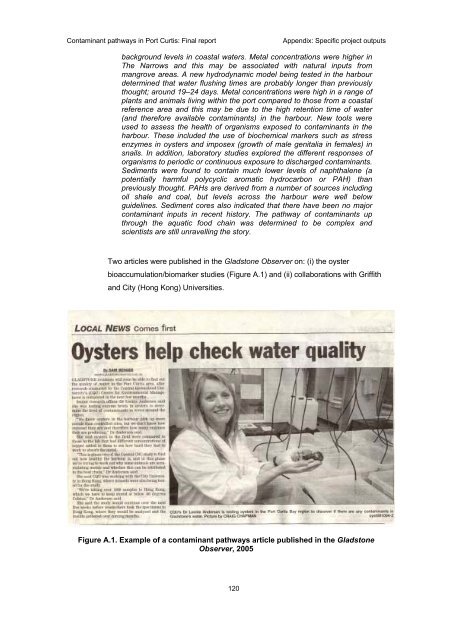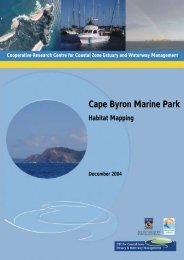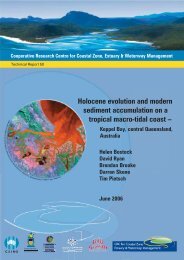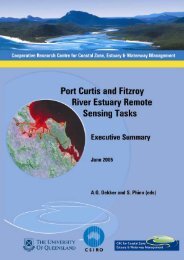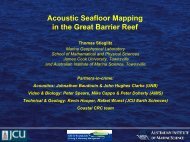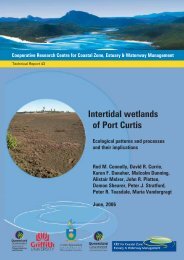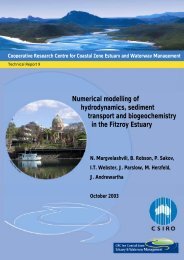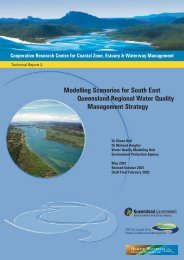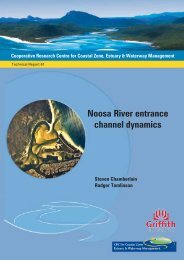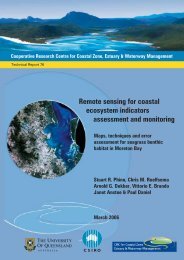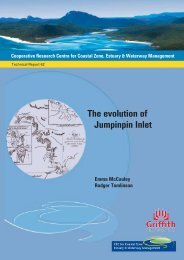<strong>Contam<strong>in</strong>ant</strong> <strong>pathways</strong> <strong>in</strong> <strong>Port</strong> <strong>Curtis</strong>: F<strong>in</strong>al <strong>report</strong>Appendix: Specific project outputsAngel, B.A., Simpson, S.L., Stauber, J.L., Jolley, D.F. (2005) ‘The effects ofcont<strong>in</strong>uous and fluctuat<strong>in</strong>g copper exposures on the mar<strong>in</strong>e algaPhaeodactylum tricornutum’. Conference Proceed<strong>in</strong>g, International conferenceon the biogeochemistry of trace elements (ICOBTE), April 3–7, Adelaide,South Australia.Andersen, L.E., Siu, W.H.L., Ch<strong>in</strong>g, E.W.K., Kwok, C.T., Melville, F., Plummer, C.,Storey, A.W. and Lam, P.K.S. (2005) ‘Antioxidant enzymes as biomarkers ofenvironmental stress <strong>in</strong> oysters <strong>in</strong> <strong>Port</strong> <strong>Curtis</strong>’. Conference presentation,Research for Coastal Management, CRC Coastal Zone, 14 September,Coolangatta, Queensland.Andersen, L.E. (2004)’ Imposex <strong>in</strong> the City: A survey to monitor the effects of TBTcontam<strong>in</strong>ation <strong>in</strong> <strong>Port</strong> <strong>Curtis</strong>, Queensland’. Conference presentation, CRCCoastal Zone, 16 September, Coolangatta, Queensland.Fabbro L.F. and Andersen, L.E. (2004) ‘Tox<strong>in</strong>s and contam<strong>in</strong>ants caus<strong>in</strong>genvironmental harm? - Bioaccumulation and identification of biological effects’.Faculty of Arts health and Sciences 2005 Lecture Series, Central QueenslandUniversity, Rockhampton.All team members presented talks at the CRC-organised one-day sem<strong>in</strong>ar on‘<strong>Contam<strong>in</strong>ant</strong>s <strong>in</strong> <strong>Port</strong> <strong>Curtis</strong>’, Gladstone, 2005.Dissem<strong>in</strong>ation of <strong>in</strong>formation through local mediaA phone <strong>in</strong>terview was held with a <strong>report</strong>er from ABC Science/News on19 October 2004 and an article appeared on their website.Radio <strong>in</strong>terview ABC Capricornia fish<strong>in</strong>g segment re: oysters as biomonitors.A phone <strong>in</strong>terview was held with a <strong>report</strong>er from The Veter<strong>in</strong>arian magaz<strong>in</strong>e on9 November 2004.The follow<strong>in</strong>g press release was issued follow<strong>in</strong>g a one-day <strong>Contam<strong>in</strong>ant</strong>Pathways workshop <strong>in</strong> Gladstone <strong>in</strong> July 2005. It was published <strong>in</strong> CQU Newsand local newspapers:Harbour Gets Second Clean Bill of HealthA second phase of research <strong>in</strong> <strong>Port</strong> <strong>Curtis</strong> recently conducted by theCoastal Cooperative Research Centre has determ<strong>in</strong>ed that the harbourstill rema<strong>in</strong>s relatively healthy. A recent presentation of results to <strong>in</strong>dustry,managers and stakeholders by the comb<strong>in</strong>ed team from CSIRO andCentral Queensland University <strong>in</strong>dicated positive f<strong>in</strong>d<strong>in</strong>gs on the health oflocal waterways. Extensive surveys of the port <strong>in</strong>cluded measur<strong>in</strong>gcontam<strong>in</strong>ants <strong>in</strong> water, sediments and mar<strong>in</strong>e organisms and exam<strong>in</strong><strong>in</strong>gthe health effects of these contam<strong>in</strong>ants on mar<strong>in</strong>e life. Althoughconcentrations of some dissolved metals were elevated <strong>in</strong> harbour water,they were not above levels of regulatory concern and returned to natural119
<strong>Contam<strong>in</strong>ant</strong> <strong>pathways</strong> <strong>in</strong> <strong>Port</strong> <strong>Curtis</strong>: F<strong>in</strong>al <strong>report</strong>Appendix: Specific project outputsbackground levels <strong>in</strong> coastal waters. Metal concentrations were higher <strong>in</strong>The Narrows and this may be associated with natural <strong>in</strong>puts frommangrove areas. A new hydrodynamic model be<strong>in</strong>g tested <strong>in</strong> the harbourdeterm<strong>in</strong>ed that water flush<strong>in</strong>g times are probably longer than previouslythought; around 19–24 days. Metal concentrations were high <strong>in</strong> a range ofplants and animals liv<strong>in</strong>g with<strong>in</strong> the port compared to those from a coastalreference area and this may be due to the high retention time of water(and therefore available contam<strong>in</strong>ants) <strong>in</strong> the harbour. New tools wereused to assess the health of organisms exposed to contam<strong>in</strong>ants <strong>in</strong> theharbour. These <strong>in</strong>cluded the use of biochemical markers such as stressenzymes <strong>in</strong> oysters and imposex (growth of male genitalia <strong>in</strong> females) <strong>in</strong>snails. In addition, laboratory studies explored the different responses oforganisms to periodic or cont<strong>in</strong>uous exposure to discharged contam<strong>in</strong>ants.Sediments were found to conta<strong>in</strong> much lower levels of naphthalene (apotentially harmful polycyclic aromatic hydrocarbon or PAH) thanpreviously thought. PAHs are derived from a number of sources <strong>in</strong>clud<strong>in</strong>goil shale and coal, but levels across the harbour were well belowguidel<strong>in</strong>es. Sediment cores also <strong>in</strong>dicated that there have been no majorcontam<strong>in</strong>ant <strong>in</strong>puts <strong>in</strong> recent history. The pathway of contam<strong>in</strong>ants upthrough the aquatic food cha<strong>in</strong> was determ<strong>in</strong>ed to be complex andscientists are still unravell<strong>in</strong>g the story.Two articles were published <strong>in</strong> the Gladstone Observer on: (i) the oysterbioaccumulation/biomarker studies (Figure A.1) and (ii) collaborations with Griffithand City (Hong Kong) Universities.Figure A.1. Example of a contam<strong>in</strong>ant <strong>pathways</strong> article published <strong>in</strong> the GladstoneObserver, 2005120


